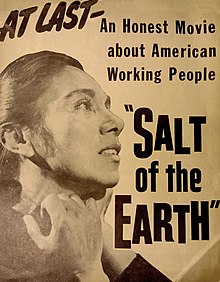| Salt of the Earth | |
|---|---|
 Theatrical release poster | |
| Directed by | Herbert J. Biberman |
| Screenplay by | Michael Wilson |
| Produced by | Paul Jarrico |
| Starring |
|
| Cinematography |
|
| Edited by |
|
| Music by | Sol Kaplan |
| Distributed by | Independent Productions |
Release date |
|
Running time | 94 minutes |
| Country | United States |
| Languages | English Spanish |
| Budget | $250,000 |
Salt of the Earth is a 1954 American film drama written by Michael Wilson, directed by Herbert J. Biberman, and produced by Paul Jarrico. Because all three men were blacklisted by the Hollywood establishment due to their alleged involvement in communist politics,[1] Salt of the Earth was one of the first independent films made outside of the Hollywood studio system.
It was also one of the first motion pictures to advance the feminist social and political point of view. Its plot centers on a long and difficult strike, based on the 1951 strike against the Empire Zinc Company in Grant County, New Mexico. The company is identified as "Delaware Zinc", and the setting is "Zinc Town, New Mexico". The film shows how the miners, the company, and the police react during the strike. Shot in a style influenced by Italian neorealism, and making atmospheric use of New Mexico's landscapes, Salt of the Earth employed mostly local miners and their families as actors.[1][2]
The film was initially mired in Red Scare controversy and was suppressed. Eventually though, it was seen by more and more people until it came to be recognized as an important cultural, political and aesthetic work. In 1992, it was selected to the Library of Congress's National Film Registry of significant U.S. films.[3]
- ^ a b Salt of the Earth at the AFI Catalog of Feature Films.
- ^ Sandhu, Sukhdev (10 March 2014). "Salt of the Earth: Made of labour, by labour, for labour". The Guardian.
- ^ McNearney, Allison (26 June 2022). "The Insane Saga of 'Salt of the Earth,' the Only Film to Be Blacklisted". Daily Beast.